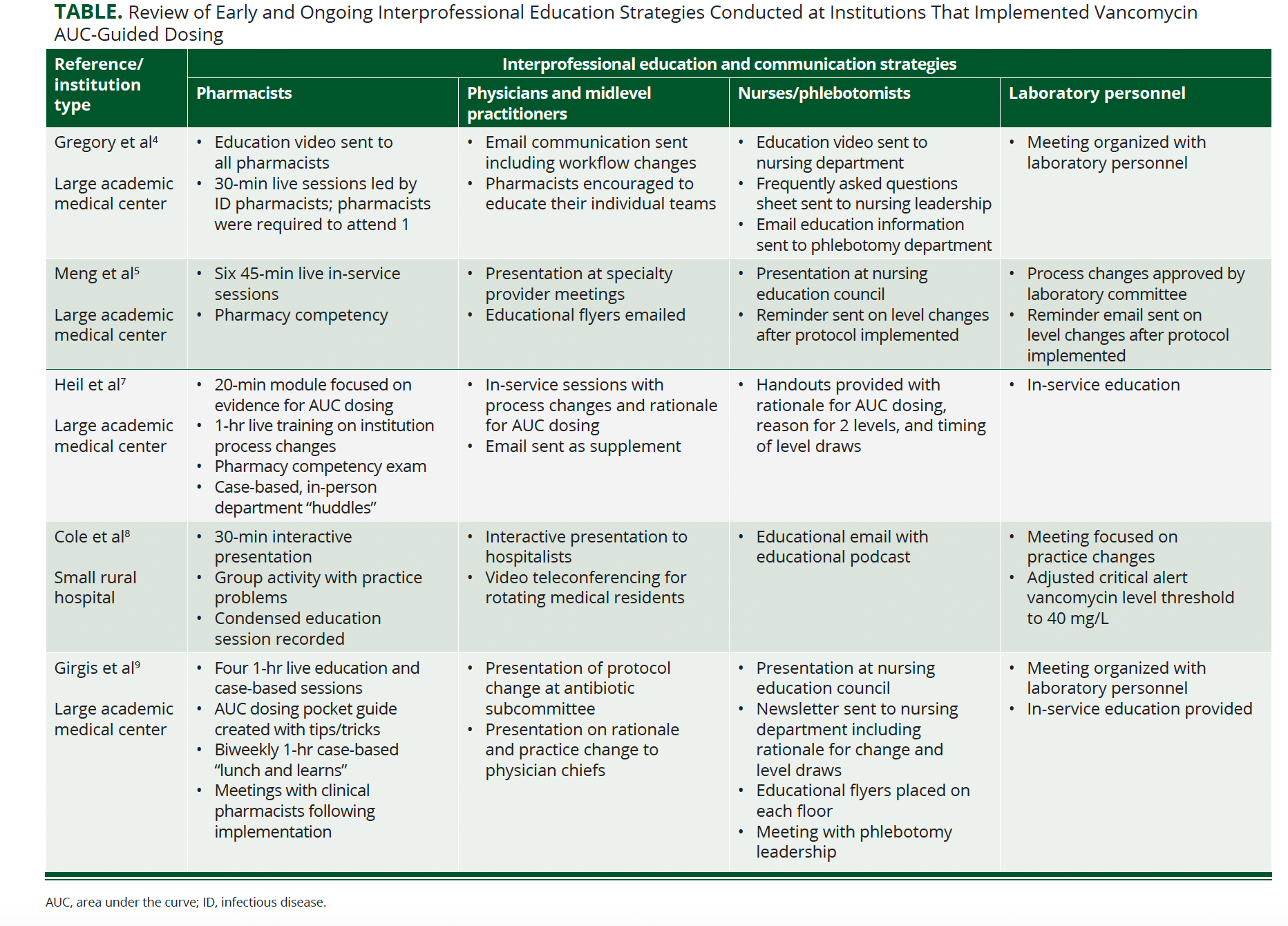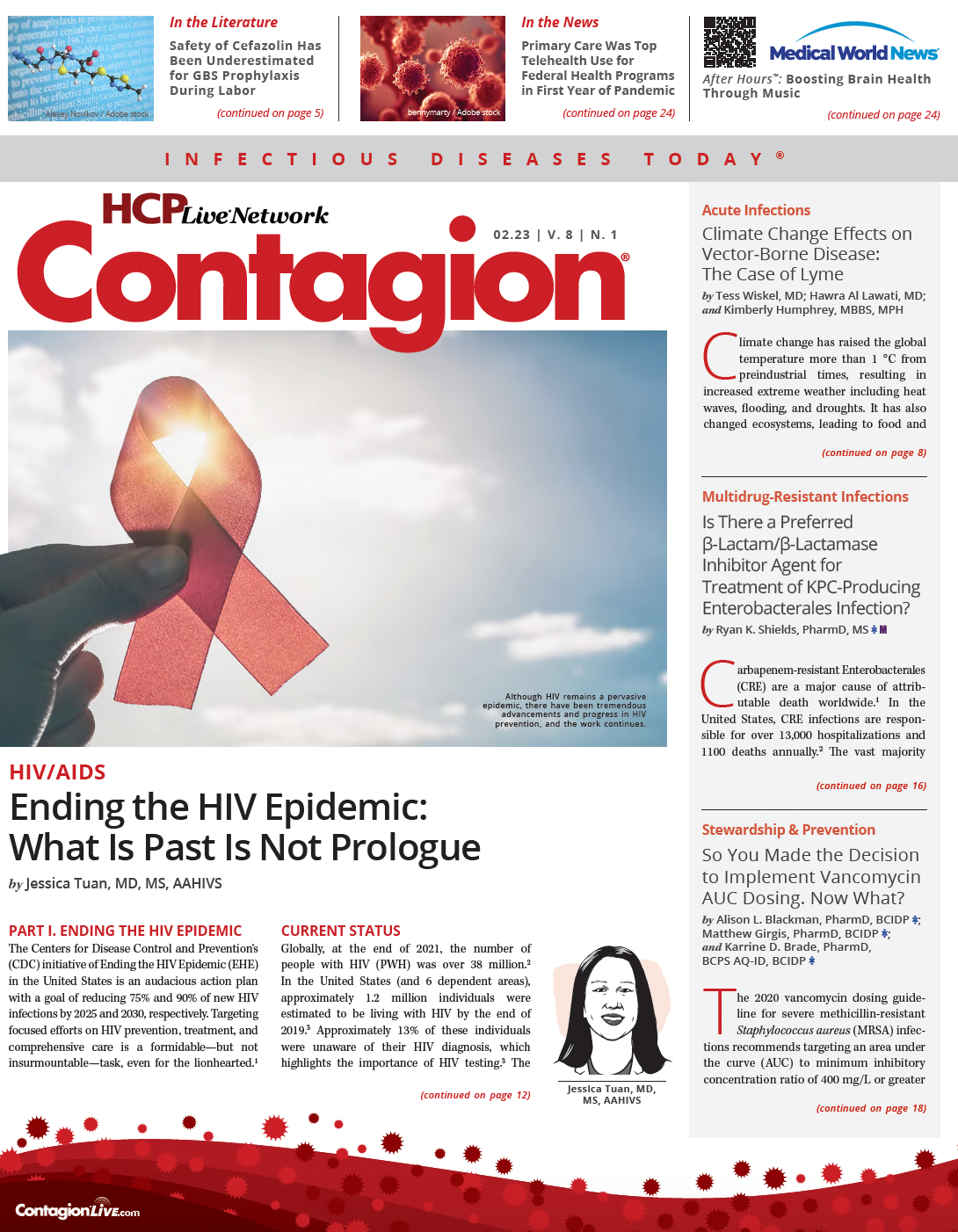So You Made the Decision to Implement Vancomycin AUC Dosing. Now What?
Since the vancomycin guideline update, institutional leaders have been faced with the challenge of implementing and monitoring AUC-guided dosing.
The 2020 vancomycin dosing guideline for severe methicillin-resistant Staphylococcus aureus (MRSA) infections recommends targeting an area under the curve (AUC) to minimum inhibitory concentration ratio of 400 mg/L or greater instead of previously recommended trough goals of 15 to 20 mg/L.1 The basis for this recommendation was driven by a reduction in vancomycin-associated nephrotoxicity seen with AUC-based dosing.1-3 Since this guideline update, institutions have been challenged with implementing and monitoring vancomycin AUC dosing. Herein, we describe important steps when making the switch to AUC-guided dosing, and strategies to consider that will ensure sustainable change.
PREPARING TO MAKE THE CHANGE
Similar to any large institutional change, the key to success for employing vancomycin AUC dosing is in the preparatory work. Institutions that have implemented vancomycin AUC-guided dosing indicate that preparation may take between 2 and 5 months.4,5 The focus at this stage includes updating vancomycin institutional guidelines, reviewing current vancomycin workflow, developing educational documents, and educating relevant stakeholders.6
There are many aspects of the vancomycin dosing process that should be discussed at the institution level. Examples include maximum empiric vancomycin total daily doses, methods of calculating renal function for patients, definitions of acute kidney injury, and vancomycin targets for non-MRSA infections.6,7 Another important aspect of implementation is how AUC calculations will be performed and through what support systems. Methods include population-based Bayesian software or 2-level first-order pharmacokinetic calculations through electronic medical record–embedded, commercially available, or institutionally developed Excel calculators.7 Resources are available online for those beginning this process through organizations such as MAD-ID, DoseMeRx, and the Society of Infectious Diseases Pharmacists, which has a “Vancomycin AUC Toolkit.” All these resources include templates for vancomycin guidelines as well as AUC dosing Excel calculators.6
There are several key personnel who should be involved early and throughout the preparation stage. Creating a workgroup of stakeholders, including infectious diseases (ID), internal medicine, critical care, and surgery pharmacists, as well as physician champions, will improve acceptance of these new processes. The workgroup should review the current vancomycin monitoring workflow and determine who will be ordering doses, scheduling labs, and monitoring vancomycin AUC-guided dosing. Additionally, they should determine the preferred documentation process and create templates for notes and daily monitoring. For institutions with robust pharmacy services, a decision of roles for centralized, decentralized, and clinical specialty pharmacist involvement should be made. Some institutions have implemented pharmacist-driven vancomycin dosing protocols, but this may not be feasible depending on resource availability. In such cases where pharmacy services are limited, physicians and midlevel practitioners would determine dosing and monitoring. For institutions that will be utilizing calculation methods requiring 2 levels, nursing and/ or phlebotomy departments will need to be included in the workgroup to discuss the impact of these changes and to make any necessary updates to their protocols. Discussion should include accuracy of level timing in respect to vancomycin doses, the relevance and importance of the peak level, and the decision to not withhold doses while a level is pending. Laboratory leadership will also need to be included to discuss the level draw changes, interpretation of critical level thresholds, and importance of level result time. For many institutions, members of the information technology department can play a key role in assisting with changes to level ordering or embedded calculators. Finally, various members of hospital leadership will need to be involved for purposes of resource acquisition and financial decisions, as well as process and protocol approvals. Buy-in and support from each of these interprofessional groups is necessary for the successful implementation of vancomycin AUC-guided dosing and monitoring.
Institutions that have implemented AUC-guided dosing stress the importance of early and ongoing education.4,5,7-10 The Table summarizes various education and communication strategies reported at sites that have implemented AUC-guided dosing. In general, literature data highlight the importance of in-person, interactive education being more effective than passive methods, such as email.4,8 The Society of Infectious Diseases Pharmacists vancomycin toolkit includes education templates for providers and nursing/phlebotomy departments.6,11,12
PROCESS ROLLOUT AND EARLY EVALUATION
How and when AUC-guided vancomycin dosing is implemented should be determined by the institution. Prior to hospital-wide implementation, a pilot period during which AUC-guided dosing is rolled out for specific indications (ie, bacteremia or infective endocarditis) or select areas of the hospital may be considered.5 This offers an opportunity to assess the need for any process changes to be adjusted before hospital-wide implementation. Champions of the AUC process change should be made available as questions arise.
Ongoing evaluation of implemented processes during this stage remains essential. Given that this would be a major institutional change, monitoring outcomes of interest (namely reducing vancomycin exposure and vancomycin-associated nephrotoxicity) is vital. For instance, Heil et al described an institutionally generated report that tracked the percentage of patients who develop acute kidney injury while receiving vancomycin.7 Cole et al conducted a gap analysis using vancomycin levels and evaluated adherence to their dosing protocol.8 Finally, Gregory et al utilized a monthly report assessing all pharmacist vancomycin notes. A survey was also distributed to pharmacists 5 months following implementation to evaluate their perception of the changes regarding efficacy and safety.4

LONG-TERM POSTIMPLEMENTATION REVIEW
Although the literature and available resources focus on methods of early (within 1 year), postimplementation evaluation of vancomycin AUC dosing, little information is available on how to create sustainable, long-standing change. With much of the focus in the preparation and implementation stages being geared toward communication and education, quality improvement initiatives suggest a regression of metrics when education is stopped.
At Boston Medical Center, an internal audit conducted 2 years following vancomycin AUC dosing rollout revealed that the pharmacy department failed to meet competency for vancomycin dosing. Appropriateness wasdefined as overall adherence to the dosing protocol, including dosing, monitoring, and documentation. Failure was defined as less than 85% appropriateness. Here, the area of failed competency was specifically seen in the appropriate vancomycin dosing/indication and failure to monitor based on institutional guidelines. Given these findings, a quality improvement initiative was implemented to develop a sustainable training process in an effort to improve appropriateness to greater than 90%. Pharmacists were required to attend a 1-hour, in-person competency (that was also recorded for those who were not available in person) and then pass an exam with a score of 80% or higher. The exam included case-based questions, and pharmacists were limited to 1 attempt. If pharmacists did not pass on their first attempt, they were required to meet for a second small group discussion with an ID pharmacist and then were given a second exam. Workflow processes were also reevaluated: All new vancomycin protocols from overnight were limited to single doses; maximum empiric doses were set to 1500 mg per dose; level ordering was limited to be drawn between 4 am and 8 pm; and vancomycin critical alert pages were changed from on-call residents to an ID pharmacist during the day to identify educational opportunities in real-time. This resulted in a sustainable change of vancomycin dose appropriateness of greater than 85%, which is now being tracked through monthly reviews on an ongoing basis.
CONCLUSION
Although literature and guideline recommendations support the switch to AUC dosing for vancomycin, how it is implemented is to be determined by individual institutions. Given the extensive nature of this practice change, it is vital for institutions to establish an interprofessional work group to discuss process changes and an education plan prior to implementation. Continued education and process revisions should be expected early post implementation. Finally, ongoing, long-term postimplementation audits should be conducted to ensure successful, sustainable change.
References
1.Rybak MJ, Le J, Lodise TP, et al. Therapeutic monitoring of vancomycin for serious methicillin-resistant Staphylococcus aureus infections: a revised consensus guideline and review by the American Society of Health-System Pharmacists, the Infectious Diseases Society of America, the Pediatric Infectious Diseases Society, and the Society of Infectious Diseases Pharmacists. Am J Health Syst Pharm. 2020;77(11):835-864. doi:10.1093/ajhp/zxaa036
2.Finch NA, Zasowski EJ, Murray KP, et al. A quasi-experiment to study the impact of vancomycin area under the concentration-time curve-guided dosing on vancomycin-associated nephrotoxicity. Antimicrob Agents Chemother. 2017;61(12):e01293-17. doi:10.1128/AAC.01293-17
3.Lodise TP, Drusano G. Vancomycin area under the curve-guided dosing and monitoring for adult and pediatric patients with suspected or documented serious methicillin-resistant Staphylococcus aureus infections: putting the safety of our patients first. Clin Infect Dis. 2021;72(9):1497-1501. doi:10.1093/cid/ciaa1744
4.Gregory ER, Burgess DR, Cotner SE, et al. Vancomycin area under the curve dosing and monitoring at an academic medical center: transition strategies and lessons learned. J Pharm Pract. 2020;33(6):774-778. doi:10.1177/0897190019834369
5.Meng L, Wong T, Huang S, et al. Conversion from vancomycin trough concentration-guided dosing to area under the curve-guided dosing using two sample measurements in adults: implementation at an academic medical center. Pharmacotherapy. 2019;39(4):433-442. doi:10.1002/phar.2234
6.Vancomycin AUC Toolkit. Society of Infectious Diseases Pharmacists. Accessed December 27, 2022. https://sidp.org/Vancomycin-AUC-Implementation-Toolkit-Guide
7.Heil EL, Claeys KC, Mynatt RP, et al. Making the change to area under the curve–based vancomycin dosing. Am J Health Syst Pharm. 2018;75(24):1986-1995. doi:10.2146/ajhp180034
8.Cole JL. Gap analysis for the conversion to area under the curve vancomycin monitoring in a small rural hospital. Fed Pract. 2020;37(suppl 3):S12-S17.
9.Girgis M, Brade K, Amin D. Hospital-wide implementation of vancomycin area under the curve/minimum inhibitory concentration (AUC/MIC) dosing at a large academic medical center. Presented at: MAD-ID 2019 Annual Meeting; May 8-11, 2019; Orlando, FL.
10.Should therapeutic monitoring of vancomycin based on area under the curve become standard practice for patients with confirmed or suspected methicillin-resistant Staphylococcus aureus infection? Can J Hosp Pharm. 2020;73(3):232-237.
11.Vancomycin AUC dosing resources. MAD-ID. Accessed January 4, 2023. https://mad-id.org/vancomycin/
12. Vancomycin AUC Conversion Toolkit. DoseMeRx. Accessed January 4, 2023. https://doseme-rx.com/vancomycin/auc-conversion-toolkit

